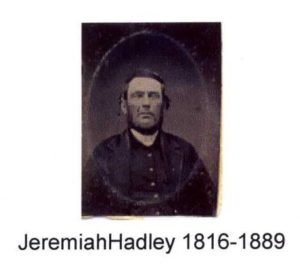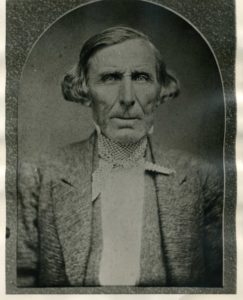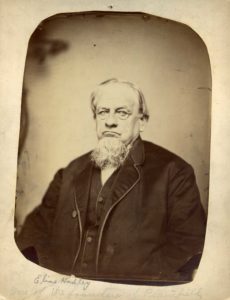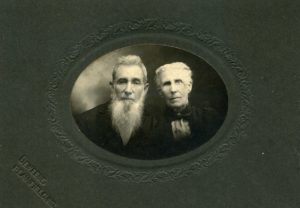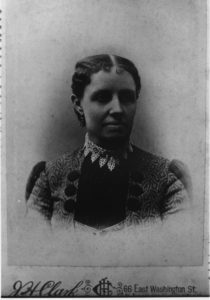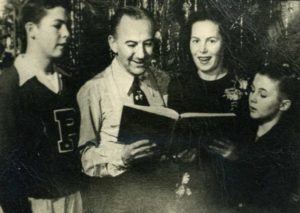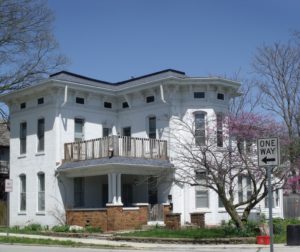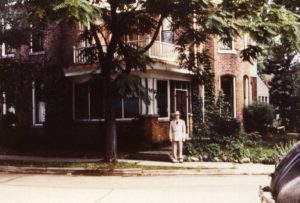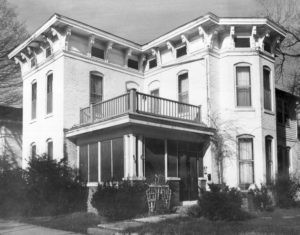This house has quite a history, and is truly an example of the old cliché, “If only these walls could talk.” If the walls here could do so, they could tell a story of Plainfield life through almost the entire timeline of the town. Many familiar names from the town’s history are associated with the home’s past.
The first record of the property comes when a patent for the land was obtained by Jeremiah Hadley, one of Plainfield’s first settlers from North Carolina, in 1823. Jeremiah went on to split up his patent and sold part the land that would become this lot to his son Elias Hadley and part to his son-in-law, David Carter.
Elias Hadley’s portion was briefly owned by Levi Jessup, but both portions were sold to the group of Abner Wiley, Isaac Holton, and Thomas Sluder to become part of their new addition to the town. The property where 135 North Vine would be built was platted as lot 3 of block 10. In 1837 Jesse Hockett bought lots 3 and 4 together at a sheriff’s sale; at that time they were in the hands of Malcolm Campbell, who defaulted on a debt to one Edmund Clark. Hockett paid $86.00 for the land.
Hockett, an early school teacher, tavern keeper, merchant, and farmer in Plainfield, split the land into two parts. He kept lots 3 and 4 together (lot 4 located next to Krewson Avenue, with lot 3 adjoining it to the south) but divided the property into eastern and western halves. Each half changed hands numerous times in the next three and a half decades. The eastern half was sold in turn to Nathan Lawrence and his wife Penninah, Christian C. and Lurena Nave, George W. and Maria Brown, Joseph and Hannah Talbot, Elwood and Eliza Harvey, Randal and Hannah McPherson, Rebecca Hoover, and Ebenezer Tomlinson.
The western half of the tract saw some interesting financial developments. Jesse and Jane Hockett sold their son Zebulon the west half of the tract in May of 1847 for $150; in August of that year he turned around and sold it back to them for $300. Five and a half years later Jesse sold the land for $350 to Wellington Crist, a tailor and sometimes carriage trimmer. In July 1954 he sued Crist for defaulting on the $150 still due for the sale. Crist was summoned to appear in court, but on August 2 when he was “three times solemnly called but come not” was declared in default for the sum of $174.70. The land went to sheriff’s sale in October and was purchased by Samuel Gossett for $201.74. In 1858 Gossett and his wife then sold it back to Wellington Crist for $25. Crist was married to Gossett’s daughter Rosannah. In 1867 he sold the land to Ebenezer S. Watson for $1000.
Although there is a metal plate on the threshold of the house with the date 1875, tax records indicate this house was built in 1880. Ebenezer Tomlinson owned the east half of the property in 1879, which was listed as valued at $45, with $100 of improvements; Ebenezer Watson owned the west half with $200 worth of improvements. In 1880, Tomlinson reunited both halves and the value of the improvements jumped to $1000, indicating the construction of a large structure, so it is reasonable to conclude the house was built at that time. Tomlinson was a dry goods merchant from North Carolina who had a wife named Damsel and a daughter named Tennessee. His brother was Moses Tomlinson, Plainfield’s “master photographer.”
The architecture of the house is Italianate, a style that was extraordinarily popular from the 1860s through the 1890s. Typical of this style, the house features wide, projecting eaves with ornate brackets, narrow windows with rounded heads, and a low-pitched hipped roof. It’s a two-story brick structure with a two-story bay, nine-inch walls, and a porch that squares out its ell shape.
On October 26, 1889, the house began a journey through six owners in less than a decade when Ebenezer Tomlinson sold it to John and Frances Carter for $2000. They kept it for five years, after which the flurry of transfers began for the property. The Carters sold it in October 1894 to James H. Carpenter and his wife Martha, who sold it in May the next year to George W. Springer. A year later George sold it back to James and Martha Carpenter who turned around and sold it in August 1896 to Edwin and Sarah Crawford, who in turn sold it in April 1897 to Amos D. Krewson, for whom the street is named.
In 1905 Krewson split up the property and sold lot 4 (the northern lot). The house and lot 3 remained in the Krewson family after Amos’ death, passing first to his daughter Susan Morrison, then to his daughter Elizabeth Arnold. She sold it in 1916 to Harriet Brown, a Chicago widow, who sold it nine days later to Mary E. Langley, the wife of a Plainfield day laborer. Again, the house underwent a series of sales, passing through the hands of Belle and Charles Havens, and Lora and Guy Cumberworth, and into the possession of John B. and Nellie Crist Vial.
John Vial was in the grocery business in Indianapolis before moving to Plainfield around 1905-1907. He was head gardener at the Indiana Boys’ School for twenty-five years, dying in 1932 at age 73. The Vials bought the house in 1918 and Nellie Vial retained ownership until 1942, but because census records indicate more than one family living there, it is reasonable to deduce the house had been divided into a multiple family dwelling.
The home was known in the early 1900s for being the residence of an eccentric author Franklin McKinzie Smith and his wife Jennie. Franklin, also known as F.M., owned an insurance agency, supported Theodore Roosevelt, and ran for public office several times, once on the Bull Moose Party ticket. Jennie Smith continued to sell her art and give painting lessons in the home on Vine Street. Eventually the Smiths moved to a house on North School (now East) Street, then on to Los Angeles around 1913. The house on School Street went to sheriff’s sale.
In 1930 Carl Kersey, who worked at the Indiana Boys’ School, lived in the house with his wife, as did Presly Christy and his family. Christy also worked for the Boys’ School, and then went into the restaurant business, purchasing the Chrisman Café in 1931, then the Green Tea Pot – where he invited former Chrisman Café patrons to a free meal. In 1932 he was running a boarding house at 108 Main Street which offered meals in a homelike atmosphere. His ad urged, “Remember Christy’s for 157 varieties of food.”
In 1940, Oscar Wiegand, his wife Louise, and son Charles had set up housekeeping. Louise Weigand was the daughter of John and Nellie Vial, so the house would have been familiar to her. Louise was something of a rarity then, a divorcee. Previously married to Chester Hadley, great-grandson of original land purchaser Jeremiah Hadley, she had a grown son named Oscar Hadley. Oscar Wiegand was a widower; his son Charles was from his first marriage. Also in the house at this time was Edwin M. Tomlinson. Tomlinson was the pastor of the Plainfield Christian church from March 1934 through October 1940 and went on to work for Westinghouse Electric Supplies. He moved to Plainfield with his widowed mother, but married in 1937 and by 1940 was living in the house with both his wife and mother.
Dr. Milo Aiken moved to town in 1933 after serving his internship at Methodist Hospital and set up his office in July that year. He purchased the house in July 1942 and kept an office there through 1951, but lived on North Center Street most of that time.
Dorothy Winsted Carneal and her husband Alfred purchased the home around 1976 and were the best known residents in the late 1970s and early 1980s. Dorothy was a well-known beautician in Plainfield who had also worked as a pianist at the Prewitt Theatre when it showed silent movies. Alfred’s parents for a time owned the Circle Inn, a restaurant located on Main Street in the 1930s.
The house on North Vine, after a past laden with Plainfield connections, continued into the twenty-first century belonging to the descendants of Dorothy and Alfred Carneal.



